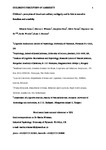Children’s perception of visual and auditory ambiguity and its link to executive functions and creativity
| dc.contributor.author | Taranu, M | |
| dc.contributor.author | Wimmer, MC | |
| dc.contributor.author | Ross, J | |
| dc.contributor.author | Farkas, D | |
| dc.contributor.author | van Ee, R | |
| dc.contributor.author | Winkler, I | |
| dc.contributor.author | Denham, SL | |
| dc.date.accessioned | 2019-05-15T12:37:38Z | |
| dc.date.issued | 2019-08 | |
| dc.identifier.issn | 0022-0965 | |
| dc.identifier.issn | 1096-0457 | |
| dc.identifier.uri | http://hdl.handle.net/10026.1/13980 | |
| dc.description.abstract |
The phenomenon of perceptual bistability provides insights into aspects of perceptual processing not normally accessible to everyday experience. However, most experiments have been conducted in adults, and it is not clear to what extent key aspects of perceptual switching change through development. The current research examined the ability of 6-, 8-, and 10-year-old children (N = 66) to switch between competing percepts of ambiguous visual and auditory stimuli and links between switching rate, executive functions, and creativity. The numbers of switches participants reported in two visual tasks (ambiguous figure and ambiguous structure from motion) and two auditory tasks (verbal transformation and auditory streaming) were measured in three 60-s blocks. In addition, inhibitory control was measured with a Stroop task, set shifting was measured with a verbal fluency task, and creativity was measured with a divergent thinking task. The numbers of perceptual switches increased in all four tasks from 6 to 10 years of age but differed across tasks in that they were higher in the verbal transformation and ambigous structure-from-motion tasks than in the ambigous figure and auditory streaming tasks for all age groups. Although perceptual switching rates differed across tasks, there were predictive relationships between switching rates in some tasks. However, little evidence for the influence of central processes on perceptual switching was found. Overall, the results support the notion that perceptual switching is largely modality and task specific and that this property is already evident when perceptual switching emerges. | |
| dc.format.extent | 123-138 | |
| dc.format.medium | Print-Electronic | |
| dc.language | en | |
| dc.language.iso | en | |
| dc.publisher | Elsevier | |
| dc.subject | Perceptual bistability | |
| dc.subject | Visual bistability | |
| dc.subject | Auditory bistability | |
| dc.subject | Perceptual switching | |
| dc.subject | Executive functions | |
| dc.subject | Creativity | |
| dc.title | Children’s perception of visual and auditory ambiguity and its link to executive functions and creativity | |
| dc.type | journal-article | |
| dc.type | Article | |
| plymouth.author-url | https://www.ncbi.nlm.nih.gov/pubmed/31029832 | |
| plymouth.volume | 184 | |
| plymouth.publication-status | Published | |
| plymouth.journal | Journal of Experimental Child Psychology | |
| dc.identifier.doi | 10.1016/j.jecp.2019.03.010 | |
| plymouth.organisational-group | /Plymouth | |
| plymouth.organisational-group | /Plymouth/Faculty of Health | |
| plymouth.organisational-group | /Plymouth/Faculty of Health/School of Psychology | |
| plymouth.organisational-group | /Plymouth/REF 2021 Researchers by UoA | |
| plymouth.organisational-group | /Plymouth/REF 2021 Researchers by UoA/UoA04 Psychology, Psychiatry and Neuroscience | |
| plymouth.organisational-group | /Plymouth/Research Groups | |
| plymouth.organisational-group | /Plymouth/Research Groups/Centre for Brain, Cognition and Behaviour (CBCB) | |
| plymouth.organisational-group | /Plymouth/Research Groups/Centre for Brain, Cognition and Behaviour (CBCB)/Brain | |
| plymouth.organisational-group | /Plymouth/Research Groups/Centre for Brain, Cognition and Behaviour (CBCB)/Cognition | |
| dc.publisher.place | United States | |
| dcterms.dateAccepted | 2019-03-25 | |
| dc.rights.embargodate | 2020-5-2 | |
| dc.identifier.eissn | 1096-0457 | |
| dc.rights.embargoperiod | Not known | |
| rioxxterms.versionofrecord | 10.1016/j.jecp.2019.03.010 | |
| rioxxterms.licenseref.uri | http://www.rioxx.net/licenses/all-rights-reserved | |
| rioxxterms.licenseref.startdate | 2019-08 | |
| rioxxterms.type | Journal Article/Review |


